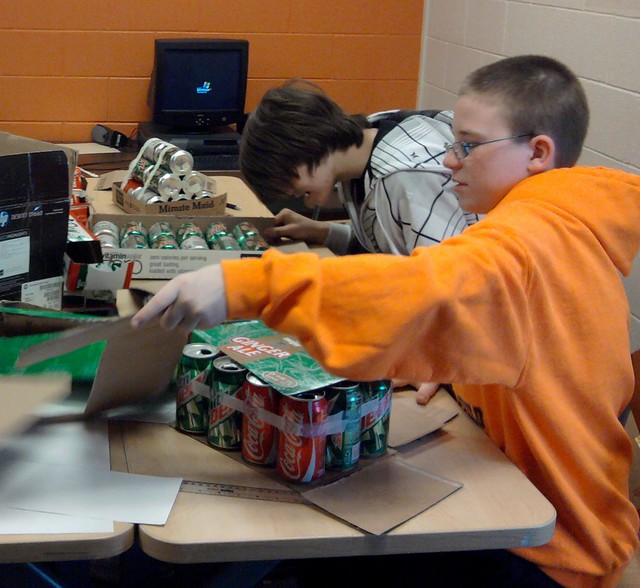I saw this quick and clean
multiplication game suggestion from the Math for Love blog, and really thought it had potential.
- Roll three dice
- Pick two to add
- multiply times the third
A little bit of choice, clean mechanic... great. But I thought that it could be jazzed up a bit. Then I thought that this was a great opportunity for the students to do game design.
The warm up problem that Mr. Schiller had suggested was pure serendipity: what is the largest area rectangle with whole length sides and a perimeter of 30 units. Maximizing a product with a constraint on the factors with multiple choices - perfect! I couldn't resist asking them after they found 7 x 8, "what if it didn't have to be whole numbers?" One student said - maybe 7\(\frac{1}{2}\)? They verified the perimeter, and I showed them a way to find the area. (Area model for multiplication is definitely one of my favorite representations.)
I shared the game and introduced the idea that we could rebuild it, make it better than before, with these prompts. (Here is
the handout I gave them.)
- Is there a context that would fit or a story to go with it? Climbing, racing, building, digging, fighting, shopping?
- Should it be a set number of rounds? How many?
- Or play to a total? What total?
- Any special actions or situations or rules?
- Is there a way to get people to try and make something besides the biggest score? Like a bonus if you get to a total that ends in zero, or something that depends on the story.

They were bursting with ideas! We shared a couple and then they got working. They quickly decided 100 was too small. A few students went completely away from the idea. Rolling a die to shop from numbered stores, or just a roll and move that many spaces game. Still a lot of pride of ownership, and some good problem solving to make the game work. Others liked the game just fine the way it was, and figured out the right total to play to; as low as 200 and as high as 1000 depending on the group. Some instituted catch up rules for if you got too far behind. (Glad to see that come back from the
Spiral Races.) Others added some player interaction by being able to buy out your opponent's roll.

One group made an Escape from Planet of the Apes game, where you race to 100 (pick the locks to escape the cages), then to 300 (escape the village), then to 600 (back to your space capsule for the final escape); this was humans escaping the apes. It's a madhouse! Actually another group also made a Planet of the Apes game, but they didn't share.
One group made a really complicated scheme where you start with 400 points, roll for more, and spend your points on chess pieces that represented bad things for your opponent. First player to zero loses. I would be very surprised if these guys are not future gamers.
Several players made gameboards for the race, with some special rules. One group's game that I got to play had a route through town with obstacles like a storm cloud, mud puddle, etc. that you had to use your points to buy, and you got points by rolling the dice. There was no really clear explanation on how you decided where you were on the path, other than gradually moving forward. These girls were less concerned with that, and it almost felt like a role-playing game. One of the designers repeatedly reassured me, "it's not rigged. At all!"
Another player made/recalled a game from her uncle, a press your luck game. I think you could make a multiplication game out of it. Here are some slightly cleaned up rules. I love how she wrote an example.
Multiply or Bust!Roll 5 dice. Scoring rolls are:
- each 1 = 100
- each 5 = 500
- 3 or more 2's = #x200
- 3 or more 3's = #x300
- 3 or more 4's = #x400
- 3 or more 6's = #x600
Set aside your scoring dice. You can reroll any remaining dice. If some of those score, add to your set aside dice. You can reroll non-scoring dice as much as you want, but if you ever roll no scoring dice, you end your turn with zero points. You can only keep scoring rolls, so you cannot set aside two 6's and hope to roll a third. Winner is first player to 5000, or the player with the most points if multiple players beat 5000.
A
very really interesting idea came from a designer who wanted a guessing game. Her initial try involved turning out the lights, but after some discussion we got to a really fun little game. Not something either one of us would have thought of by ourselves.
Masquerade - 2 players
Roll three dice but keep them hidden. Add two then multiply by the third and tell your opponent the score. They get three guesses to try to win your dice. If they guess a number right, they get the die and score that many points. After the third guess, players switch who is the roller and the guesser. Each player gets five turns guessing. Highest point total wins.
We closed by students sharing their games. I often encouraged students to write out their rules, which was an interesting ELA activity.

I also had a couple ideas inspired by their warm up question. Here's what I would try.
The main benefit of the grid is to make non-maximal multiplications more interesting. Hopefully it adds a layer of strategy.
Of course, it would be a nice variation to play on the same grid. More interaction, more strategy, and I think the little products are bound to be better. I'll be trying these out!
The game design aspects of these 5th grade lessons has been pretty powerful. We lose a bit of focus on the mathematical objective compared to all playing a set game, but the engagement is high, and the mathematical practices are strongly present, as well as having more math done than in many traditional math lessons. Even comparing the energy the students invested in the warmup problem, which correlated roughly with their mathematical self-identity, with the very similar problem of figuring out the sum and product of the dice in the initial game was a stark contrast.





























